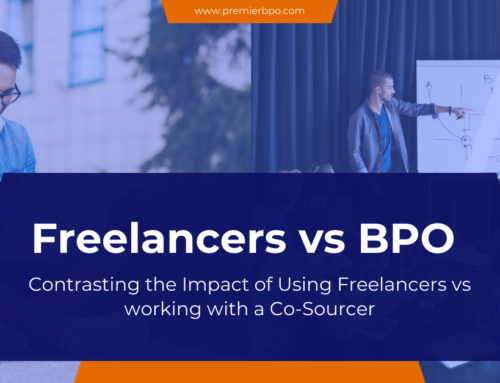COVID-19 has impacted more of our lives than we realize today; from health, family, to work, its long-term effects have revolutionized traditional approaches to each aforementioned. Forced into social distancing, the world adapted to WFH, and just as restrictions were lifted and vaccines distributed; people started to return to work and soon after, they began to leave. The major concern today for businesses across the globe is overcoming the Great Resignation, also termed as the Big Quit, which has caused talent shortage and attrition to go through the roof. How can your firm possibly function in this day and age if you cannot get people to stay and work? The alternate then, is offshore outsourcing or co-sourcing, as discussed furthermore below.
Co-Sourcing is defined as a type of outsourcing in which an externally hired company acts as a part of your in-house operation while promoting shared risk and reward values. As seasoned outsourcers can provide the necessary specialized knowledge, skills, and resources for your particular business functions, they are a perfect fit to overcome barriers during a labor crisis.

Co-Sourcing is defined as a type of outsourcing in which an externally hired company acts as a part of your in-house operation while promoting shared risk and reward values. As outsourcers can provide the necessary specialized knowledge, skills, and resources for your particular business functions, they are a perfect fit to overcome barriers during a labor crisis.
THE GREAT RESIGNATION IS HERE AND IT’S REAL
4.5 million Americans quit their jobs in November 2021, creating a new record – CNBC
The term dubbed by the Bureau of Labor Statistics is “Quits” for the highest number of resignations recorded as seen in the U.S in one month only. One may wonder, what is the Big Quit exactly? What caused the Great Resignation 2021? And why is everyone quitting their jobs?
20 million people have voluntarily left their jobs since April 2021 – marketplace.org
As defined by Anthony Klotz, Phycologist at Texas A&M, “the Great Resignation” (also coined by him), is the mass exodus that occurred in light of life lessons people learned from the pandemic and its after-effects. As a result, everyone is reimagining their lifestyles, looking for better opportunities, and moving on to greater things.
WHY ARE PEOPLE QUITTING THEIR JOBS?
Fired, furloughed, retired, taking care of long-term COVID patients, themselves, or children, not wanting to be employed, or looking to exchange careers; these were some of the reasons for not working; as discovered in a recent Household Pulse Survey.
Some other sources as cited on news forums include loan pardons, pandemic relief checks, people beginning their own startups, looking for higher pay scales, and demanding flexible work environments – (The Atlantic). If the modern worker cannot receive these altogether in a nicely wrapped package, then they will go looking for the same elsewhere. (Forbes)
According to a worldwide poll by Monster.com, 95% of people are considering quitting their jobs for a better opportunity – Inc.com
And,
86% of employers responded that they are worried about employees resigning in a recent recruiter survey – Indeed
The fact is, people have rearranged priorities to make WFH part of everyday life during the lockdown to vaccine journey. Most people have no intention to return to work full time when they can manage the routine or a second job in a remote capacity. According to a survey by Harvard Business School:
81% of people working remotely during the pandemic do not want to return to work or desire a hybrid schedule – cnet
According to a survey by WFHresearch,
31.2% of respondents want 5 days of WFH post-COVID to be the work norm
Recruiters are doing their best to keep up with hiring challenges; with some putting AI adaptation to the test and others deeming a more empathic ear towards applicants to be effective. Some feel that the modern worker’s primary concern today is safety, inclusion, and remote work allowance – hrdrive
Certain experts state that employers are also to share the blame; as they cannot find relevant talent because of unwillingness to pay what applicants demand (TIME), requirements of highly-experienced personnel for every role, and not following up enough with applicants to avoid ghosting (hrdrive).
THE GREAT RESIGNATION IS LEADING TO HIGHER COSTS OF EMPLOYING WORKERS
Since the work dynamic is permanently altered now (CNBC), organizations have no choice but to provide better incentives, more pay, health insurance, WFH capability, and more on-job perks to retain employees. Even with millions of job openings (Fortune) and the government pushing to increase minimum wage up to $15 an hour in many states, employees are refusing to return.
It massively consumes money, time, and resources to replace an employee, especially in light of a mindset to not work. Although it makes sense to opt for a higher-paying job; it is not the only deciding factor anymore.
It takes between 32 – 46 days to hire an employee in the U.S. on average and six months for a company to recoup the cost of a new hire – Zippia
And,
The cost to replace an employee ranges from one-half to two times their salary – Gallup
Also,
The overall costs of replacing an employee (turnover, training, attrition, etc.) range between 90% to 200% for any organization – SHRM via enrich
Nowadays, to engage an employee in the office, you have to pay extra and provide added perks that were previously not necessary. A recent Robert Half survey revealed that one in three workers would look for a new job if asked to return full-time – hrdrive. Consequently, large enterprises started increasing salaries from the baseline to retain employees, topping with additional benefits and health packages.
30% salary increase was announced by Goldman Sachs for entry-level employees in Aug 2021 – WSJ
And,
Deloitte is offering a $500 WFH subsidy compensation package with 15 paid holidays, mental health benefits, and annual boosts to employees – hrdrive.
After so much effort is put in, whether the employee chooses to stay or not; organizations still have to bear the cost. With global competition, large companies can go above and beyond to snap up remaining talent; but what of those mid-size companies that can’t afford to? Paying bonuses or incentives for showing up for an interview may not work for everyone; which makes it nearly impossible for those companies to recruit who can’t resort to such measures.

OUTSOURCING TO SURVIVE THE BIG QUIT 2021
Some are claiming the Great Raise 2022 (Fortune) to be an acting solution to the Great Resignation. However, certain companies can’t afford to implement it; that is why Co-Sourcing or an outsourcing partnership is their best option. Others term a more permanent solution to be changing the attitudes of managers entirely, in addition to all modern job perks (Gallup). The issue remains the same; what would you do even after all this, if your employees don’t want to work for you?
With people rethinking the importance of a full work week, voluntary labor shortage due to separations is causing businesses to face unprecedented challenges. As they grapple to attract any form of talent new or old; outsourcing is the alternative that can help manage retention and rising employing costs at the same time. If remote work is to be part and parcel of the new work norm, then why not avail the global talent advantage?
83% of employers said that shift to remote work has been very successful for their companies – PWC survey
To stay in the game, organizations need to break down work into tasks that can be allocated into different roles. A potent solution is to let an external co-sourcing firm evaluate your internal processes to bring on the necessary staff immediately.
Offshore teams provide the necessary turnkey solutions that help businesses stay running in these difficult times. With the potential to generate $600 bn from services outsourcing (OA), destinations such as the Philippines, LATAM, Pakistan, and China are emerging as favorable US labor arbitrage locations.
Often mistaken to be the tool of only large enterprises to leverage, outsourcing can be effectively applied to companies of all sizes. One of the hidden benefits of utilizing an outsourcer is that it is their responsibility to pay employee taxes on all accounts. Especially in the accelerated labor shortage in the U.S, offshore teams provide advantages such as:
a highly capable, 24/7 available, skilled, vast talent pool
lowered attrition rates
reduction of internal and overhead costs by more than 50%
excellent service quality with technical support
customized business solutions
flexible and instantly scalable teams
data-redundancy, and much more.
With the labor shortage showing no signs of easing up, corporations need to evaluate the use of the global offshore advantage to keep the proverbial lights on (Outsource Accelerator). The Great Resignation has created a labor shortage that can only be addressed with a global talent pool offered by offshoring. As businesses are sometimes skeptical of the well-established benefits of an outsourcer or co-sourcing partner, Premier BPO provides the critical insight that only a true, seasoned partner can offer. Becoming your guide in all things outsourcing, we focus on mutually beneficial outcomes based on shared risk and reward models, while we give proactive advice regarding your business. Visit our website to get a free customized consultancy, our services to see what we do, or our blog page to find out more about outsourcing.
 Skip to content
Skip to content





